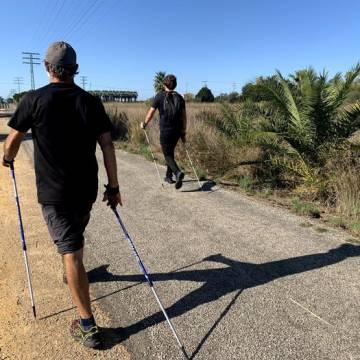





Very easy route to start in the world of Nordic Walking.
Route on good pavement, with sections of compacted gravel and asphalt layer.
Enjoy Nordic Walking among orange trees.
Dénia's Vía Verde, on the old FEVE Carcaixent-Dénia railway line, crosses a sea of orange trees parallel to the coast to the north of the historic city that lies at the foot of the Montgó.
The old line is a pleasant route to go to the beach of Las Marinas, neighbouring villages or continue to the Marjal de Pego-Oliva Natural Park.

Dénia's Vía Verdecorresponds at its southern end to the extinct Carcagente/Carcaixent - Dénia railway line, the oldest narrow gauge in the Peninsula which was in operation for 90 years.
The first section Carcaixent - Gandía dates back to 1864 and it began to operate as an animal-drawn tram along its 35 km of track. Later, in 1884, it was extended to Dénia, now as a conventional steam-powered railway.
With a marked agricultural vocation, this train's main commercial activity was the transport of citrus fruits from the Valencian orchards to the port of Dénia.
Its quiet running was interrupted in 1969, when the Carcaixent-Gandía section was closed. However, a few years later a small part of its route (between Tavernes and Gandía) would be occupied by a modern suburban train from Valencia via Silla-Cullera. The first wide-track trains arrived in Gandía in 1972.
The second section Dénia-Gandía was closed in 1974 in the hope that its route would serve as an extension of the Cercanías to Dénia. But the project was not carried out.
After 36 years of abandonment, during which there were attempts to reopen the railway, the track has come back to life in 2010 thanks to the impulse of Dénia Town Council and the conditioning works carried out within the framework of the Natural Roads Programme of the Ministry of the Environment. Now there are hundreds of cyclists and walkers, of all kinds and conditions, who travel the 5.8 km through the municipality of Dénia every day.
Dénia's old train station is the most outstanding building of the whole railway line. Nowadays, it houses the Toy Museum, a tribute to the city's toy tradition, which included many factories in the 20th century. It is completed with an exhibition hall.

